Does it matter when you carry out your work? On the one hand, we all have our own individual tastes and predispositions: after a few weeks of remote work you notice when your most productive, creative part of the day falls.
On the other hand, scientists agree that we are “programmed” biologically for greater activity at certain times of the day. So if you have the feeling that time is running out of your fingers or that you work too long but not efficiently, it’s time to look at how you use your time when you work remotely.
Freelancer’s working day
How many hours do freelancers work? The survey by Useme shows that the freelancer’s working time depends on the industry in which he operates. Copywriters work the shortest – their work time during the day is on average two hours shorter than a full-time employee’s “day”. In turn, graphic designers and programmers work two hours longer.
The survey also shows that among freelancers it’s hard to talk about one model of time management: only 5% of respondents stick to fixed working hours. 32% of freelancers work at rather regular hours, but the remaining 63% of respondents don’t have a set time frame and their working time changes.
The best time for freelancing and working remotely
Do you notice the moment of the greatest productivity during the whole day? Psychologist Ron Friedman in a statement for Harvard Business Review claims that it falls in the first three hours since we start working – then we are the most concentrated and we have the highest level of cognitive abilities.
Productivity decreases the closer to noon we get – around 3 in the afternoon, melatonin production increases and it is generally more difficult to focus on tasks. It’s good to keep this in mind when planning tasks for a given day.
Spend the beginning of the day on the tasks you find most difficult. Do not waste your “golden hours” on dealing with someone else’s matters or replying to emails, just because you are so used to it.
Do not waste time: breaks and home office
Home office has one big plus: no one imposes what your to-do list should look like. This means that you can include the necessary breaks in your day plan. Why are those break worth it and why should we stop considering the time spent on rest as lost from a professional point of view?
Tony Schwatz, a founder of The Energy Project, proves that the human biological clock also works on a micro-scale: during the day we go through several cycles, lasting from 90 to 120 minutes.
If after two hours of working you feel it is time to get up, stretch your bones or take your mind off things and give your head a rest, do not force yourself to work. All you need is 5 minutes for a short relaxation to return to the desk with a new supply of energy.
You do not want to expose yourself to the temptation of procrastination? Make friends with the Pomodoro technique, with which it will be easier for you to “stay on course” of short breaks and hard work. The Pomodoro technique is used by many different applications and software. We recommend the PomodoDone App – it works not only as a handy task management application but also as a time counter and invoicing tool.
Home office – how to create a good schedule?
The “to-do” lists and applications that count working time, such as PomoDone, are invaluable help for many of us in the implementation of the project. But what if, regardless of your level of motivation, small tasks literally eat up your time and you feel that you work long but not efficiently? You don’t have to implement revolutionary changes or give up your habits – at least not all of them. Effective planning is the key to success. Therefore, instead of entering all tasks to do on the list of tasks, approach it strategically.
- Effective remote work: the most important thing to start with Put the highest priority tasks at the very top of the list: let it be the third place at the most if you like to start the day with coffee and a quick review of business emails. Make the most of the first three hours since you sit down to the computer – as concentration decreases and fatigue increases, more difficult tasks will become even more demanding.
- Effective remote work: a productive afternoon You are a bit drowsy in the afternoon and you find it harder to force yourself to work effectively? Do not fight it – this rhythm of activity is a legacy of our distant ancestors and is rooted much deeper than the tradition of to-do list and freelancing. Plan tasks that require less effort in the afternoon: correspondence, marketing your services, browsing remote job offers.
- Effective remote work: plan the end of your work In the era of ubiquitous mobile devices and 24/7 access to the network, it’s easy to get the impression that all tasks are equally important and to lose the line between private and professional life. Therefore, plan what the end of your working day should look like: what will you do last, what time will you go offline as a freelancer. Thanks to this, you will feel that you are leaving work and you can relax.
- Effective remote work: “to-do list” and physical activity Your ally is also movement and physical activity. It’s not just about staying fit after a long day of stationary work. According to research conducted by the Dutch Institute of Social Sciences, the more time you devote to exercise, the less will be the level of fatigue you feel after working. Note – exercise should make you at least a little bit tired! The paradox of this relationship is that those of you who exercise occasionally will benefit more from physical activity than those who practice it regularly.



